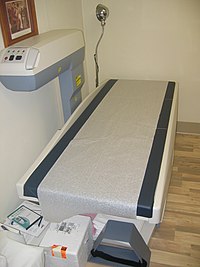
Photo from wikipedia
In the randomized, placebo‐controlled, double‐blind phase 3 ACTIVE study (NCT01343004), 18 months of abaloparatide 80 μg daily (subcutaneous injection) in postmenopausal women at risk of osteoporotic fracture significantly reduced the risk of… Click to show full abstract
In the randomized, placebo‐controlled, double‐blind phase 3 ACTIVE study (NCT01343004), 18 months of abaloparatide 80 μg daily (subcutaneous injection) in postmenopausal women at risk of osteoporotic fracture significantly reduced the risk of vertebral, nonvertebral, clinical, and major osteoporotic fractures and significantly increased bone mineral density (BMD) versus placebo regardless of baseline risk factors. Women from the abaloparatide and placebo groups who completed ACTIVE were eligible for ACTIVExtend (NCT01657162), in which all enrollees received sequential, open‐label monotherapy with alendronate 70 mg once weekly for up to 24 months. This prespecified analysis evaluated whether fracture risk reductions and bone mineral density (BMD) gains associated with abaloparatide during ACTIVE persisted through the full 43‐month ACTIVE–ACTIVExtend study period in nine prespecified baseline risk subgroups. Baseline risk subgroups included BMD T‐score at the lumbar spine, total hip, and femoral neck (≤ − 2.5 versus > − 2.5 and ≤ −3.0 versus > − 3.0), history of nonvertebral fracture (yes/no), prevalent vertebral fracture (yes/no), and age (<65 versus 65 to <75 versus ≥75 years). Forest plots display treatment effect. Treatment‐by‐subgroup interactions were tested using the Breslow‐Day test, Cox proportional hazards model, and ANCOVA model. After the combined ACTIVE–ACTIVExtend study period, reductions in relative risk for new vertebral, nonvertebral, clinical, and major osteoporotic fractures were greater among patients in the abaloparatide/alendronate group than among those in the placebo/alendronate group across all nine baseline risk subgroups. BMD gains at the lumbar spine, total hip, and femoral neck were greater in the abaloparatide/alendronate group versus the placebo/alendronate group. No clinically meaningful interaction between treatment assignment and any baseline risk variable was observed. The sequence of abaloparatide for 18 months followed by alendronate for up to 24 months appears to be an effective treatment option for a wide range of postmenopausal women at risk for osteoporotic fractures. © 2019 The Authors. Journal of Bone and Mineral Research published by Wiley Periodicals, Inc.
Journal Title: Journal of Bone and Mineral Research
Year Published: 2019
Link to full text (if available)
Share on Social Media: Sign Up to like & get
recommendations!